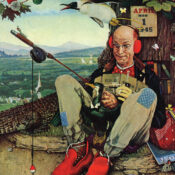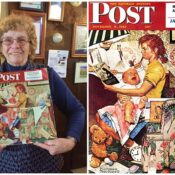Like a novelist, Norman Rockwell had a keen eye for small moments in ordinary life that signified broader trends. One such discovery occurred in the summer of 1919 when Rockwell, his wife Irene, and her family travelled to Potsdam, New York, to celebrate homecoming at Irene’s alma mater, Potsdam Normal School. In honor of his wife, Rockwell illustrated the cover for the special anniversary issue of the school’s alumni magazine—a gift popular with all of the attendees, especially Irene. For the first time, Rockwell felt like one of the family.
After the festivities, the family gathered at their summer camp a few miles away in Louisville Landing. Relaxing on the shoreline of the St. Lawrence River, conversations led to predictions about the future decade.
A spirited discussion followed, but soon Rockwell’s brother-in-law, Howard, and Irene’s father grew restless and invited Rockwell to walk with them. The three men eventually ended up at the town’s small dance hall, watching out-of-towners dance to the latest hits. As fascinating as the dancers were, several couples ringing the perimeter of the dance floor—sitting face-to-face, knee-to-knee and moving small heart-shaped objects (planchettes) on Ouija boards—were even more intriguing to Rockwell. Recalling their earlier conversation, the artist joked to Howard, “Maybe they can predict what the ’20s will bring.”
Nothing more was said about the matter, but six months later on February 3, 1920, Howard visited Rockwell in his New Rochelle studio to wish him happy birthday. Walking over to a couple of paintings resting on easels, he commented to Rockwell, “This looks like one of the couples using the Ouija board last summer.”
In fact, it was. The previous summer’s weekend celebration in Potsdam inspired the illustration “Ouija Board” featured on the May 1, 1920, cover of The Saturday Evening Post (above). Norman thought it was a trendy cover, perfect for the new decade, and used New York City models Betty Keough and Henry Von Bousen in the illustration.
Another canvas nearby featured a young couple looking at blueprints of a new house with a small child beside them. Howard asked, “Will this be the Rockwell family someday?”
“I don’t know,” the artist replied. “Do you have a Ouija board?”
Become a Saturday Evening Post member and enjoy unlimited access. Subscribe now




Comments
is it possible to order print back issues of The Saturday Evening Post?